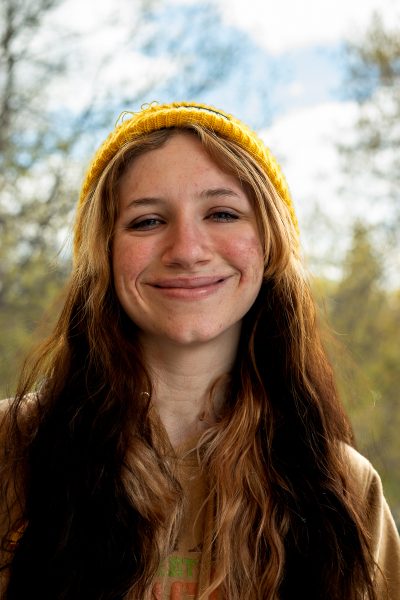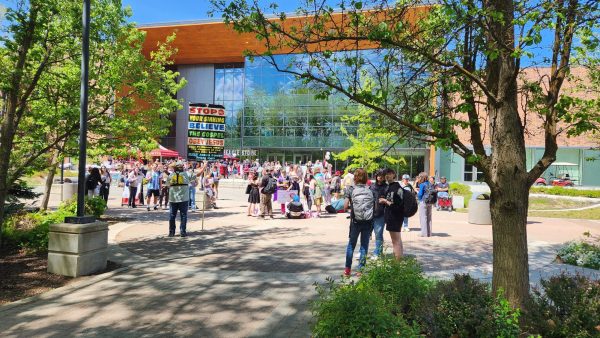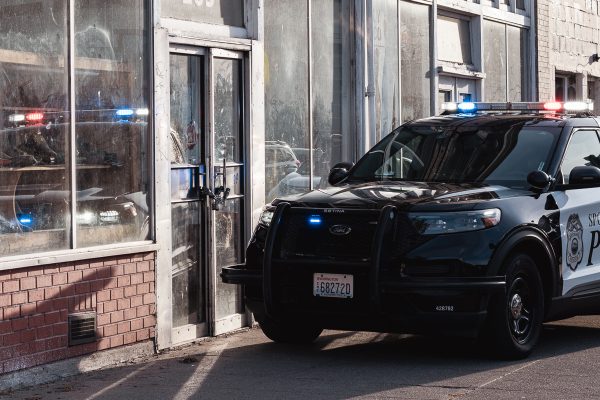Día de los Muertos altar honors influential Mexican authors
November 7, 2013

On Oct. 31 through Nov. 2 in Mexico, Central America, Spain and Latino communities across the globe, communities celebrated Día de los Muertos, “The Day of the Dead,”a celebration not of life, but of death.
In Cheney Hall, room 205, a traditional lace-draped altar was set up. Students and staff left ofrendas—offerings or food—and written tributes to anyone whose memory they wished to celebrate or remember. Traditional food was served and Latino music flowed from a boombox out into the hallway, catching the attention of students rushing off to their next classes.
Below the wall of letters, offerings of loved ones’ favorite foods and drinks were nestled among Mexican chocolates and a stone bowl of dried chili peppers. There were buttons, made by office assistant Vickie Roig, featuring traditional artwork. Candies, bright orange marigolds—a flower symbolizing death in many cultures —intricate sculptures of sugar skulls, representing the sweetness and sadness of life, tiny white figurines called “Calaveras,” and tall candles populated the long altar, creating a feast for the senses and the spirit.
“In many places in Mexico, there are all these images and art relating to death, and parades where people dress up as dead,” said Spain native Natalia Ruiz-Rubio, assistant professor of Spanish.
“The day of the dead is [a] festive, bright celebration to remember the dead. It is an opportunity to remember that they are still with us. They are not gone. It is our responsibility to keep their memories alive, and that’s why it’s not a sad celebration in any way.”
Professor Miguel Novella recently moved from Mexico City to join the EWU Spanish department.
Novella said that the holiday offers both an opportunity to honor the deceased and to remember that death is a part of life.
“The skulls and these kinds of things are not to be morbid. It’s not to be scary, but maybe just to see that death is a part of life and it has to be something that is always present,” he said.
For Rachel Smith, a senior Spanish major, the altar provided a fresh perspective of her chosen major.
She spent four months studying in Costa Rica last spring, and despite witnessing elaborate Easter celebrations there, the skeletons and macabre of this holiday surprised her.
Día de los Muertos is known for intricate costumes resembling ornate skeletons, and detailed face paintings of skulls marked in swirling, tattoo-like patterns. Creativity and community are major aspects of the Day of the Dead festivities.
“The art is not a kind of high art, it is a community art,” Ruiz-Rubio said. “The altar came from that idea, it is how the Catholic religion started being practiced when it started mixing with indigenous traditions along the way —a kind of hybridity, a blending in between [the] occidental view on death and the indigenous view on death.”
The lively music and bright signs pointing into room 205 were too much to ignore for freshman Paul Ebreo, who wandered into a scene similar to his childhood.
“What I find interesting is that they have everything here too, just like in the Philippines,” he said.
Ebreo immigrated to rural Bridgeport, Wash., with his family at age 14. He said the ofrendas on the altar brought back memories of growing up in the Philippines, with the exception that they did not have altars.
“On Oct. 31 we go to the cemeteries and clean the tombs of our families, and then on Nov. 1 we go and celebrate, spend the whole day there. We bring candles, food and eat [at the cemeteries]. So many people celebrate that you cannot drive. You have to park far away and walk in,” Ebreo said.
Spanish Professor Barbara Loste said that this year the department, students and faculty decided to give offerings to influential Spanish authors. Their books were displayed alongside portraits. All the books can be checked out from the JFK Library.
This is the second year that Eastern Spanish professors have celebrated The Day of the Dead by installing an altar.
It was the work of Miguel Novella, Professor Marge Andrews, and Loste both of whom have lived in Latin America. They received help from teacher assistants Nicole Zimmerman and Shayla Novella.
Novella said that the most important takeaway for attendees of the Día de los Muertos altar is to recognize the similarities, rather than the differences, between cultures.





![Simmons said the biggest reasons for her success this year were “God, hard work, and trusting [her] coach and what she has planned.”](https://theeasterner.org/wp-content/uploads/2024/05/image1-1-1200x800.jpg)


![Simmons said the biggest reasons for her success this year were “God, hard work, and trusting [her] coach and what she has planned.”](https://theeasterner.org/wp-content/uploads/2024/05/image1-1-600x400.jpg)






